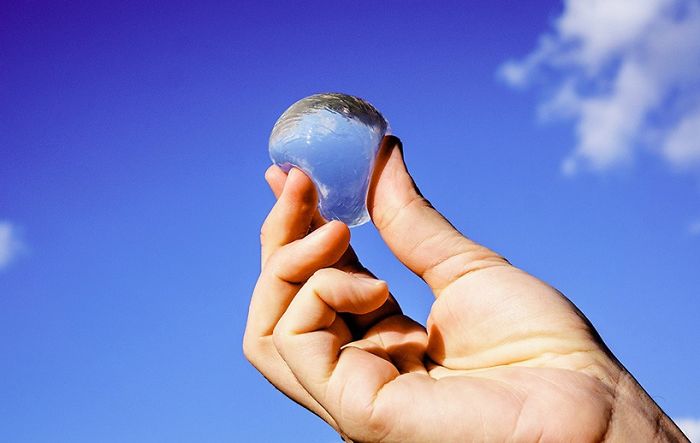
It is known that plastic bottles take hundreds of years to decompose. This is very harmful to our environment. Therefore, environmentalists are trying different alternatives, such as reusable water bottles and water fountains. Although environmentalist encourage these alternatives they are not very effective. There is pollution all over the world and in the US itself there is 50 million plastic bottles annually. About eighty percent of the plastic bottles end up in landfills. With that being said there are people at the Imperial of London who have been working on an innovative solution, water bubbles. The water is encased in a container made of seaweed, making it edible.
The process of making these bubbles involves a two-step culinary process known as spherification. At first, they start with a frozen ball of water or juice and immerse it into a calcium chloride solution. That forms a gelatinous layer and the ball is then soaked in a solution made from brown algae extract. This reinforces the structure so it won’t break. The total cost for this biodegradable packaging only costs two cents each. If left unused the product will decompose in 4-6 weeks!
Especially after so many global issues continually popping up on the radar this new innovation would help us take a huge leap forward in trying to reduce humans wastes. There are so many issues that we are creating by just throwing out a small plastic straw we can’t even imagine. I think that if biodegradable water bubbles replaced plastic water bottles we would be able to decrease our waste by millions of tons. This will help us take a good step forward in protecting our environment, the animals we affect, and even our future selves!
Katarzyna Mosio (3)
This is a very interesting alternative to using plastic water bottles! The environmental damage caused by one-use plastic products is undeniable. My one concern with this product is its shelf-life. If this outer, gelatinous layer decomposes within 4-6 weeks, are we able to sell it in stores? After manufacturing and distributing, this product might only have a couple of weeks on shelves before it begins to decompose. Also, what will this product be packaged in? Although all efforts are important when considering environmental preservation, if this product will be packaged in plastic products for shipment, we will still be creating unnecessary plastic waste.
ReplyDeletePosted by: Hayley Fecko
Yes i definitely agree with you about the short shelf-life of this product. I think that in order for consumers to be more likely to chose the water bubble over a plastic water bottle the product must be able to have a shelf-life of at least a couple months. I also think that more research has to go into how this product will be packaged and distributed because if we continue to use plastic containers to package then it will defeat the purpose of the water bubble.
Deleteposted by: Katarzyna Mosio
This is so cool! I think the fact that we are even able to possibly make such a thing is a huge testament to the advances that science is allowing, and I think this could be essential to improving the state of our planet. One concern I have is limiting the production of plastic water bottles as many companies will likely be inclined to continue producing them. Do you see this is a possible solution or part of a solution to our waste problems? Also would there be ways to transport such things over long distances or would they need to be produced fairly locally?
ReplyDeleteAlexandra McGuire
I agree that the pollution and wastes we are creating is increasing at an alarming rate and this is one step closer to even the mindset this country needs to be in. I do think that this could make a big impact in the amount of waste we produce especially plastic waste. I think that they still need to work out some kinks with transport and packaging in order to make this product completely feasible.
DeletePosted by: Katarzyna Mosio
I think this is the first step towards a society in which we use entirely composable bottles, utensils and other packaging. Although the arguments made above are fair, such as shelf-life, packaging, and limiting the production of other plastics, I think this design will be improved upon and become a more realistic alternative to plastic water bottles. Because the amount of pollution that is harming our planet is so alarming and the rate at which it is accumulating is equally as scary, there is no other choice but to rid ourselves of plastic products. I am curious about the size of these water bubbles. Is the picture accurate?
ReplyDeletePosted by Jamie Courtney
I agree with you on that the design will most likely be improved in order to make this product more appealing to consumers and more realistic. Something needs to be done about our carbon footprint and I think that this will help us get started. I do believe the bubbles are around the size pictured!
DeletePosted by: Katarzyna Mosio
This is definitely something that would reduce our footprint on the world. The only problem is how science will be able to package and distribute them throughout the world; it might take years to get one country to adapt to the new system. I hope that this research inspires more scientists to think big and find more renewable energy sources and expand earth-healthy choices for the community.
ReplyDelete-Rachel Klett